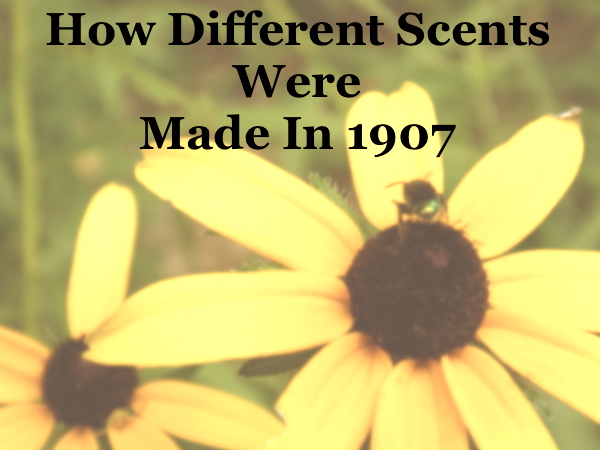
A scent is not always what it seems, according to this article from 1907 that explains how different scents were combined to mock the scents of other flowers and herbs.

Some Sweet Odors
From the very earliest ages man has loved sweet odors. In the Bible we read of the burning of incense on altars, and the very word perfumery (under which head we may include all delicate fumes or smells) comes from the Latin, of fumus, smoke or vapor.
The early Egyptians knew the use of the still, and adapted it to the separation of the odorous principle from fragrant plants, but the most ancient odors were drawn from natural gums, such as camphor, myrrh and cinnamon.
Sweet odors are of three kinds – the floral, the aromal and the balsamic. The first group includes all those derived from sweet smelling flowers and plants; the second, those derived from musks and resins; the third, those derived from leaves and gums. The otto, or essential oil of perfumes, is obtained in three ways – distillation, maceration and enfleurage.
In distillation, the odorous principle is purified and separated from the grosser parts by evaporation and subsequent condensation. An essential oil thus procured from orange flowers, bears in commerce to this day the name of Neroli, named after and dating from the time of the Emperor Nero.
In maceration, the primary substance is softened by pointing, and then dissolved by steeping in a liquid, usually alcoholic. In enfleurage, the odors are extracted by immersing the flowers or plants in grease. The fat absorbs the odors, and to remove it the fat is placed in alcohol; the odor then leaves the fat and enters into the spirit, which thus becomes scented.
In the manufacture of perfumes, art has improved on nature, and the perfumer must be a good chemist. Such odors as Jockey Club, West End, Mousselaine, Milefleur and a host of others have no counterpart in garden or grove.
The delicate heliotrope, for instance, is scarce and unprofitable to the perfumer. He detects in its odor, however, the aroma of vanilla combined with the sharper scent of bitter almonds.
Therefore, he adds to a tincture of vanilla a small quantity of otto of bitter almonds and rose and orange flower essence, and thus easily makes extract of heliotrope.
The magnolia has a pleasing perfume, but the odor is imitated to perfection without using the flower at all, because it is too large to macerate with success. So the magnolia perfume is furnished by a mixture of orange flower, rose, tuberose and violet essences, which makes a fine “extract of magnolia.”
Indian lemongrass likewise gives “extract of verbena.” With rose as a foundation and a dash of verbena, the perfume of the delicate and fleeting “sweet brier” is obtained.
Of the animal substances, ambergris, the secretion of a spermaceti whale, gives mellowness and permanency to mixers. Civet, a secretion of the African and Indian cat, has an odor harmonizing with floral compounds.
Musk is found in the small pocket or pouch of the musk deer of China, Tonquin and Tibet. It is so powerful, aromatic and persistent that one part of musk will scent more than three thousand parts of inodorous powder.
Of the spice series, caraway and nutmeg are largely used, and cloves enter into many perfumes with high-sounding names. Cinnamon or cassia is largely used. Cinnamon or cassia is the bark of a tree. Cassia comes from China, the true cinnamon from Ceylon, and the two odorous grasses are natives of India; one is known as the “lemon grass,” from which all out “extracts of verbena” and “verbena water” are made, a little addition of lemon essence making the counterfeit complete.
Source: Los Angeles herald. (Los Angeles [Calif.]), 16 June 1907.

